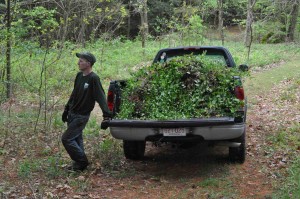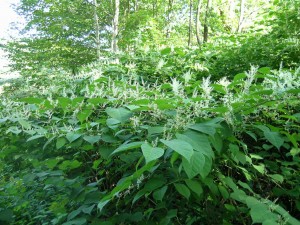Would you like a side of history with that? Toward a more holistic public history practice
12 September 2012 – Kate Preissler
preservation, methods, public engagement, museums, environment, sustainability, education, new professionals
Around the time that I took on my current position with The Trustees of Reservations, the organization made an internal change: our historic resources department became the cultural landscapes department, our historic resources staff the cultural resources staff. Why was this significant? Because unlike the previous title, which focused on properties with historic structures, any one of our 107 properties can now be looked at and interpreted as a cultural landscape and the scope of work is broadened tenfold.
The idea behind the change was consistent with what I had come to hold close to my heart: there is no firm line dividing human history and the natural history of the earth we live on. Landscapes that we view as “natural” or “ecological” are just as rich with a legacy of human intervention, meaning, and memory as those for which the buildings and artifacts remain as a more tangible reminder. Our “historical” properties often have ecological or environmental stories to share along with the human ones. The change in terminology acknowledged that identifying some properties as specifically historic created an unfortunate “silo-ing” effect between departments and may have hindered innovation.
After three years of holding this lens to our properties, I’m happy to stand back and see the difference it has made for our region’s programming. It has been exciting to see history bleeding into programs that previously would not have contained it.
For example, I love that we have begun referring to the historical antecedents of our Youth Conservation Corps programs in marketing materials, grants, staff training, and with the youth themselves. “Rooted in the spirit of the Civilian Conservation Corps of the 1930s…” is how many of our descriptions of the program now start. We did not change the program into “a history program”– the teens spend most of their time working in parks, on farms and on trails around their communities–but by making the association with another moment in history, the program feels anchored in time and the staff and participants can feel connected through the spirit of service and hard work to those people of the past.
The change also illuminated another period in American history when money was scarce, work was hard to find, and people were struggling to make better lives; all experiences that most of our participants and their families are going through. For the team of youth that I work with in Holyoke, the connection is deepened by the fact that many of their projects takes place on Mt. Tom, a site shaped by a CCC crew in 1933. The Holyoke Youth Conservation Corps is in its seventh year of doing work projects on Mt. Tom but it is only within the last couple of years that we’ve made a direct link between the program and the people who had worked the land before them.
The flip side, of course, is that we have begun to integrate other topics into the programming at our traditional historic sites. One example is a series of programs which use both our historic gardens and natural sites to educate visitors on the importance of native pollinators and train people to create landscapes that encourage their abundance. We are also looking into programming that would use our designed landscapes to highlight how some of the choices made by individuals in the past have impacted our ecosystems (for instance the introduction of decorative plants that turned out to be invasive species, like Japanese knotweed which is still cultivated at Naumkeag).
Overall, our efforts have focused on smaller-scale additions and shifts, not major program overhauls. When multiplied across sites, I believe these small infusions will strengthen our endeavors by intertwining heritage and ecology in an organic and meaningful way.
I feel empowered and energized by the breakdown of the invisible lines that denoted which properties and programs were “about history” and which were about other things. To me it is a natural extension of seeing beyond the walls of an historic home and into the surrounding landscape, but I also know that this mixing and mingling is strategic and supportive of the broad mission of The Trustees.
With this in mind, I’d be interested to hear others’ perspectives on interdisciplinary programming at historic sites:
- Do you think that ecology programs hosted at historic sites enhance the visitor experience, or do they dilute the story of the place that we’re trying to tell?
- When is it appropriate to add breadth and diversity to the subjects being covered at your site, and when does it become “mission-creep”?
- At sites where little physical evidence of human intervention remains, how can we interpret the history in ways that are not too conceptual for visitors to engage with?
- I work primarily with fusions of ecology, sustainability and cultural history – what other subject areas have made for successful interdisciplinary programming at your historic sites?
During this coming season I will continue to work with my colleagues, partners, and communities to add a little history here and there where I can, and to engage people on a variety of topics at all of our sites. I’m especially looking forward to gathering feedback from our visitors and participants and gauging the success of this new way of working.
~ Kate Preissler, Trustees of Reservations
Additional notes on images:
(1) The Ashley House and Bartholomew’s Cobble, A National Natural Landmark, are adjacent. For years we have provided information on the history of the Ashley House to visitors at the Cobble, but we have not integrated information on the ecological restoration work that we do at both sites, like the invasive garlic mustard removal seen here at the Ashley House.
(2) Our field staff spend countless hours removing invasive plants from our properties. But at Naumkeag, Japanese Knotweed is part of the historic garden plan and is therefore preserved and cultivated. Its presence in the designed historic landscape offers a great opportunity to inform visitors as to how aesthetic choices of the past have impacted our ecosystems today.






Kate, I think these are excellent issues for the sustainability discussions to which I think interdisciplinary programming and interpretation seem pretty essential. I attended the a Preservation Education conference in Providence this past weekend, and pretty much EVERYONE agreed that an interdisciplinary approach is the future. Have you seen the point paper posted on this blog?
What a great article and great idea to have a land trust-type organization be so interdisciplinary. I work for a county land preservation organization where there are clear cut lines between natural history, cultural history, and recreation. I wish we could blur these more.
Yes, and I have been very excited with all of the discussions concerning sustainability going on in the history world and especially with NCPH, although I have not yet had the chance to be an in-person part of them.
In fact, our Cultural Resources Department sits within a “Sustainability Department” which includes Ecology, Infrastructure and Green Technologies, Community and Land Conservation, Volunteerism, and Engagement.
Although for this blog I have been focusing on the public history aspects of my work, the end goal for all of my engagement efforts are to support the organization-wide vision of promoting healthy, sustainable communities and healthy resilient landscapes. Connecting people to places is one way to motivate people to act for their protection, their health and for the preservation of the memories that reside there.
This gets at a really great issue that pervades those of us who work in historic preservation. Often times the objectives for cultural resource, or historic resource, management and natural resource management are perceived as being at odds with each other. The Cultural Landscape Foundation has been focusing on this issue, dubbing it the Nature-Culture Divide. Wouldn’t it be great if we could see it as less of a divide and more as an overlay of resources that presents great opportunities? The integration of history and cultural resources into various programs and sites is a great example of how seemingly disparate goals can work together to strengthen the overall resource.
Japanese knotweed, Yikes! I really, really hope that every shoe that sets foot in that garden is carefully cleaned before it leaves the premises. Otherwise, that lovely historical garden is spreading one of the nation’s worst invasives everywhere those shoes go.
I was intrigued by the “historically-correct” Japanese knotweed, too! (Can it really spread just by people having walked where it’s growing?)
This raises questions about the extent to which it’s actually desirable to re-create a particular historical landscape. Is the presence of an authentic plant worth it aesthetically or historically if we’ve come to recognize it as an invasive species? Might it be more useful to the public to have a plaque that notes that Japanese knotweed once grew here (w/ a photo, maybe), with an explanation about why it’s not such a good idea anymore? I’m thinking that we wouldn’t spray a historic orchard with lead-arsenate (okay, maybe that’s an extreme example…), so I wonder about the choices that were weighed in keeping the knotweed here.
That’s what makes that a great example! If we don’t start communicating with the world of ecology more, we become part of the problem instead of contributing to a healthy, resilient community. Many invasive plant species made their way to the U.S. as imports for the fancy, decorative gardens we continue to maintain as historic sites, and the consequences over the last decades have been dire.
This example also exemplifies one of the reasons why, as Sara mentioned, these fields have often been at odds. Often the decisions that retain the most historic integrity are not the ones that are best for our local ecosystems.
Luckily, our staff includes an ecologist who specializes (somewhat out of necesity these days) in invasive species control and helps us to minimize the risk and make plans for utilizing healthier options as we restore our gardens as places like Naumkeag. I do, however, worry for all of the historic gardens that cultivate Autumn Olive, Honeysuckle, Hardy Kiwi, Norway Maples, Purple Loostrife and other invasive species that aren’t lucky enough to be able to have an on-staff ecologist to help to fully understand the potential — the probable — effects of their preservation work.
As a clarification, Japanese Knotweed spreads primarily via its crown and root mass, not as much with seeds. The patch at our site does not get direct visitor interaction, so its unlikely that any material is getting tracked out. Were we to have any plant material that was an immediate ecological threat to surrounding areas, the question of historical accuracy would have been irrelevant.
Thanks for a good discussion of this topic. It is so important for specialists in different fields to work together on sustainability of our landscapes, natural or cultural (are the two ever separate). Plantings are one topic, but there is more too as some other comments have mentioned: chemical use, lawn maintenance, water use, building materials. The Trustees are lucky to have an interdisciplinary team, and they are very willing to share their work with others.